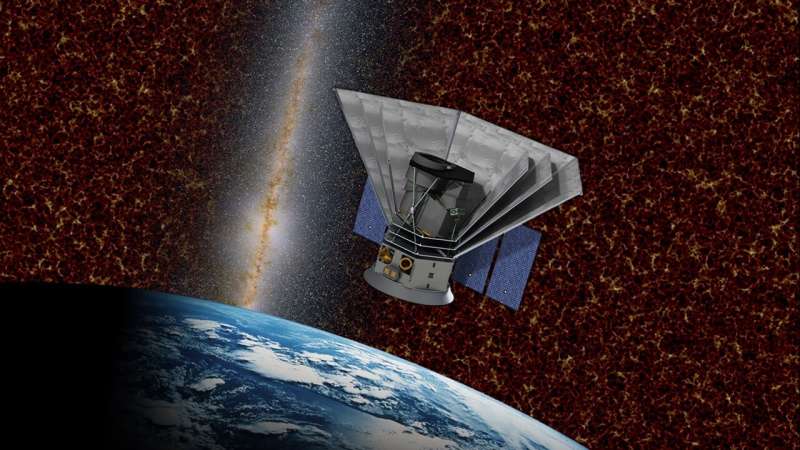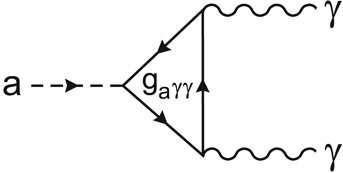December 14, 2022 feature
Could axion decay underlie excess cosmic optical background?

The cosmic optical background (COB) is the visible light emitted by all sources outside of the Milky Way. This faint glow of light, which can only be observed using very precise and sophisticated telescopes, could help astrophysics to learn more about the origins of the universe and what lies beyond our galaxy.
Last year, physicists working at different institutes across the United States published the most precise COB measurements collected so far, gathered by the New Horizons spacecraft, an interplanetary space probe launched by NASA over a decade ago. These measurements suggested that the COB is two times brighter than theoretical predictions.
Researchers at Johns Hopkins University have recently carried out a theoretical study exploring the possibility that this observed excess light could be caused by the decay of a hypothesized type of dark matter particles, known as axions. In their paper, published in Physical Review Letters, they showed that axions with masses between 8 and 20 eV could potentially account for the excess COB flux measured by the New Horizons team.
"Marc Postman is a colleague across the street who is an incredible observational cosmologist, and so when his paper with Todd Lauer and the New Horizons team appeared, I noticed it and read it," Marc Kamionkowski, one of the researchers who carried out the study, told Phys.org.
"The measurement they collected is a great example of cleverly repurposing a powerful astronomical observatory to different ends than those it was designed for. We sent this incredible little spacecraft out toward Pluto years ago, and it did everything it was supposed to, but it had no brakes, and is still speeding further and further from the sun with not much to do. Marc and Todd realized that it could be used to detect—for the very first time—the cosmic background of optical photons from all the unresolved galaxies in the universe, and it did."

After reading the paper by Lauer and his colleagues, Kamionkowski realized that if the excess they measured was in-fact attributed to the decay of axions, this could be potentially confirmed using available cosmological data. Specifically, this excess would be detected with a high signal-to-noise ratio during SPHEREx, a planned two-year NASA mission that will send a near-infrared space observatory into space to collect new and potentially valuable measurements.
"Our calculations are embarrassingly simple, as they are the types of calculations that we and tons of other people have been doing for years," Kamionkowski explained. "The idea that two-photon decay of an axion could lead to a cosmic signal was already around when I was a graduate student over 30 years ago. Our work simply involves summing the photons from all those produced by axion decay over time, a simple integral. We had to get some factors of cosmic redshift in there correctly, but that's a homework problem in a typical cosmology class."
Overall, the calculations performed by Kamionkowski and his colleagues highlight the possibility of confirming or disproving the connection between axion dark matter decay and the recently observed excess COB using future line-intensity-mapping (LIM) measurements set to be collected by NASA's SPHEREx satellite.
SPHEREx is expected to launch in 2025, collecting measuring near-infrared signals originating from approximately 450 million galaxies. The researchers at Johns Hopkins have already published a follow-up paper, where they explored the consistency of the axion decay scenario with existing constraints to COB from gamma rays.
"NASA's Fermi telescope has obtained gamma-ray energy spectra from over 800 blazars, and the highest-energy gamma rays can be attenuated by production of electron-positron pairs via scattering with COB photons," Kamionkowski added.
"In our new study, we modeled the attenuation expected from this COB scattering and by comparing with Fermi data were able to place an upper limit to the COB background from dark-matter decay, which was still consistent with the COB excess inferred from New Horizons.
"My student Gabriela Sato-Polito has also been working with Dan Grin (Haverford College) looking in deep VLT images of several high-redshift clusters for dark-matter decay lines. These measurements should allow us to probe some, but not all, of the parameter space for dark-matter decays consistent with the New Horizons excess."
More information: José Luis Bernal et al, Cosmic Optical Background Excess, Dark Matter, and Line-Intensity Mapping, Physical Review Letters (2022). DOI: 10.1103/PhysRevLett.129.231301
Tod R. Lauer et al, New Horizons Observations of the Cosmic Optical Background, The Astrophysical Journal (2021). DOI: 10.3847/1538-4357/abc881
José Luis Bernal et al, Seeking dark matter with γ-ray attenuation, arXiv (2022). DOI: 10.48550/arxiv.2208.13794
Journal information: Physical Review Letters , Astrophysical Journal , arXiv
© 2022 Science X Network





















